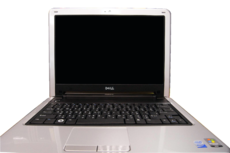Dell Inspiron Mini 9
| Type | Subnotebook/Netbook |
|---|---|
| Operating system |
Dell Ubuntu Netbook Remix Microsoft Windows XP |
| Developer | Dell |
|---|---|
| Type | Netbook |
| Discontinued | May 29, 2009 |
| Media | 4/8/16/32/64 GB SSD |
| Operating system | Windows XP Home ULCPC SP3, Dell Ubuntu Netbook Remix with and without Moblin |
| CPU | Diamondville Intel Atom N270 (1.6 GHz/533Mhz FSB/512K cache) |
| Memory | 512 MB, 1GB or 2GB |
| Display | Glossy 8.9" (22.6 cm) 1024x600 LCD (133 dpi) |
| Input |
Keyboard Touchpad Microphone 0.3 or 1.3 Megapixel Webcam |
| Connectivity | 10/100 Mbit Ethernet 802.11b/g wireless LAN Bluetooth Optional/Standard (depends on region) VGA 15-pin output Audio; headphone/mic jacks 3 USB 2.0 ports 4-in-1 Flash Memory card reader, WWAN (Mobile Internet) |
 |
|
| Developer | Dell |
|---|---|
| Type | Netbook |
| Operating system | Windows XP Pro |
| CPU | Intel Atom Z520 or Z530. |
| Memory | 1 GB of shared dual channel DDR2 SDRAM @ 533 MHz |
| Graphics | integrated Intel GMA 500 graphics |
| Connectivity | 3 USB 2.0 ports, 1 Fast Ethernet port, 1 VGA output, 1 headphone jack, 1 microphone jack, 1 3-in-1 memory card reader and 1 power adapter connecter |
The Dell Inspiron Mini Series is a line of subnotebook/netbook computers designed by Dell. The series was introduced in September 2008 amidst the growing popularity of low-cost netbook computers introduced by competitors.
The Dell Inspiron Mini 9 (also called the Inspiron 910), was announced on September 4, 2008, as a netbook set to contend with other low cost ultra-portables such as the ASUS Eee PC and Acer Aspire One. The Mini 9 was also sold as the Dell Vostro A90 by the Dell Small Business Unit.
The Mini 9 began shipping on September 16, 2008, starting at US$349. It is built by Compal Electronics, which also makes the MSI Wind Netbook and the HP Mini-Note 2133.
Dell initially shipped versions of the Mini 9 with only partially usable storage, after models were built using a software image that fit just the basic 4GB SSD. Standard operating system upgrades later fixed the issue.
The Mini 9 uses a very special SSD drive. It is a 50mm solid state module (MO-300A) with mini PCIe interface. It uses IDE/PATA signal, so replacing it with a module with SATA signal won't work, although it will fit in the socket.
In January, it was suspected that some units were shipping with 24 watt-hour capacity batteries, labeled as 32 watt-hour. The low-capacity batteries appear to be those manufactured in Tokyo. It was later determined that the software used to examine the batteries was incorrectly reporting the capacity and has since been reported to be fixed with an upgrade of the BIOS.
Dell has sold two models under the "Mini 10" branding, distinguished by model number.
The Mini 10 (1010) is a netbook with a 10.1" screen that was designed to fill the gap between the Mini 9 and Mini 12. It began shipping on February 26, 2009 with a base price of US$399.
It has the Intel Atom Z520 and Z530 processor configurations. The default Mini 10 model has a 16:9 widescreen display with a 1024x600 (originally 1024x576) or 1366x768 (described as 720p) HD resolution and an HDMI port. It uses the Poulsbo chipset. It can be customized with GPS or integrated TV tuner. The service manual displays two full-height MiniPCI-E internal slots, and one half-height. It is unclear whether the connectors are all in place, but the manual shows one full-height TV tuner in place.
...
Wikipedia
